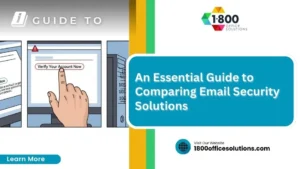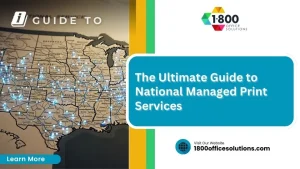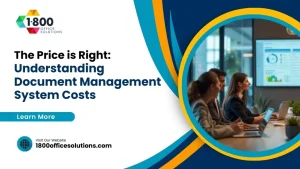Compliance Management Systems Explained: The Ultimate Guide
A compliance management system is a crucial tool for businesses navigating the tangled web of regulations and standards that govern various industries. In today’s world, regulatory requirements are continuously evolving, making it vital for organizations to have a structured approach to manage compliance effectively. But what exactly does a compliance management system do?
- Streamlines regulatory adherence by integrating compliance procedures into daily operations.
- Mitigates risks by identifying and addressing potential non-compliance issues.
- Improves accountability by assigning clear responsibilities for compliance oversight.
- Facilitates continuous monitoring and updates to stay in line with changing regulations.
These systems play a pivotal role in ensuring that businesses not only meet legal obligations but also uphold ethical standards.
As someone who has spent over a decade in the office equipment industry, I’ve had the opportunity to witness the challenges faced by companies in maintaining regulatory compliance. My background in information systems and extensive experience with compliance management systems equip me with the insights necessary to guide organizations in creating effective compliance frameworks.
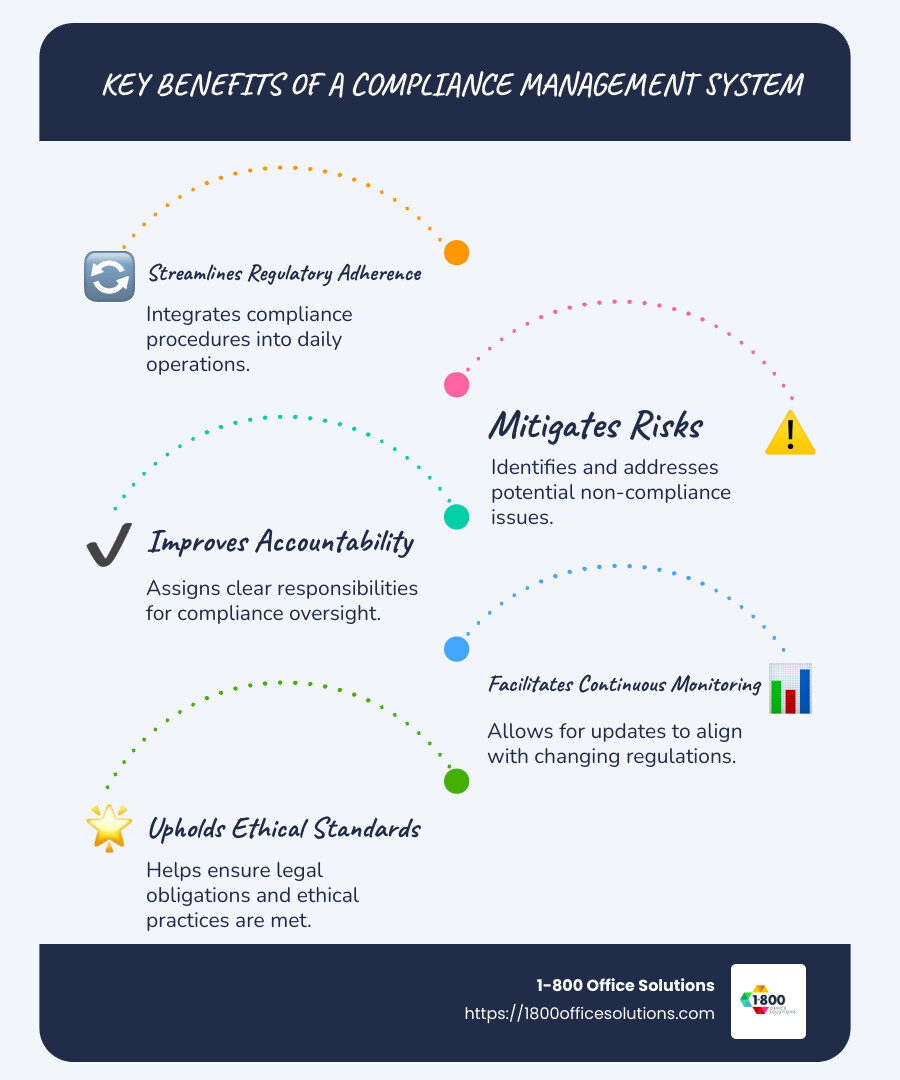
Learn more about compliance management system:
A compliance management system (CMS) serves as the foundation of a business’s strategy for handling rules and regulations. It’s a comprehensive setup that assists companies in adhering to legal requirements and their own internal policies. Let’s explore its components.
Integrated System
Consider a CMS as a complex puzzle where each piece contributes to a complete compliance picture. It integrates various tools, processes, and controls into a unified system. This integration ensures that every aspect of the business aligns with compliance objectives. From risk assessments to compliance training, each element collaborates to prevent any oversights.
Regulatory Compliance
Regulatory compliance involves adhering to rules established by governments and industry bodies. These regulations can be stringent and frequently updated, such as GDPR for data protection in the EU or HIPAA for healthcare in the U.S. A CMS aids businesses in tracking these regulations and staying updated with any changes, helping them avoid significant fines and legal issues, like the $1.3 billion fine Meta faced in 2023 for GDPR violations.
Internal Controls
Internal controls are the processes and procedures that ensure a business operates smoothly and securely. Within a CMS, these controls are tailored to ensure compliance with both external regulations and internal policies. They function as safeguards, preventing breaches or compliance lapses. For instance, companies might employ automated systems to monitor compliance in real-time, minimizing human error and enabling swift responses to any issues.

A compliance management system is an essential tool for any organization navigating the complex landscape of regulations. It unifies various elements to create a cohesive approach to compliance, ensuring that businesses not only fulfill legal obligations but also uphold high ethical standards.
Key Components of a Compliance Management System
Building a strong compliance management system (CMS) involves several key components. Let’s explore the most important ones: board oversight, the compliance program, and compliance audits.
Board Oversight
The board of directors plays a crucial role in setting the tone for compliance. Their involvement signals that compliance is a priority for the organization.
Why is this important? Because when the board prioritizes compliance, it encourages everyone else to follow suit. This creates a culture where everyone knows compliance isn’t just a checkbox but an essential part of doing business.
Board oversight involves creating comprehensive compliance policies and ensuring these are communicated effectively throughout the organization. This oversight guarantees that organizations meet federal consumer protection laws and regulations.
Compliance Program
The compliance program is the heart of any CMS. It’s where all the planning and execution happen to ensure compliance across the organization.
A well-designed compliance program includes:
- Structured Policies and Procedures: These are the rules everyone follows to stay compliant. Clear policies help employees understand their roles and responsibilities.
- Employee Training: Regular training ensures that everyone knows the latest compliance requirements and how to meet them. This is crucial because regulations can change, and staying updated is key.
- Risk Assessments: Identifying and evaluating potential compliance risks helps organizations prioritize and address them before they become bigger issues.
- Complaint Handling: A standardized process for addressing consumer complaints can help identify regulatory issues early and maintain customer loyalty.
Compliance Audits
Compliance audits are like health check-ups for your compliance program. They assess how well the organization follows its own policies and regulatory requirements.
Audits can be internal or external:
- Internal Audits: Conducted by the organization itself to ensure ongoing compliance and identify any gaps.
- External Audits: Performed by independent parties to provide an unbiased assessment of compliance status.
Both types of audits are essential for maintaining transparency and accountability. They help organizations identify areas for improvement and demonstrate compliance to regulators and stakeholders.
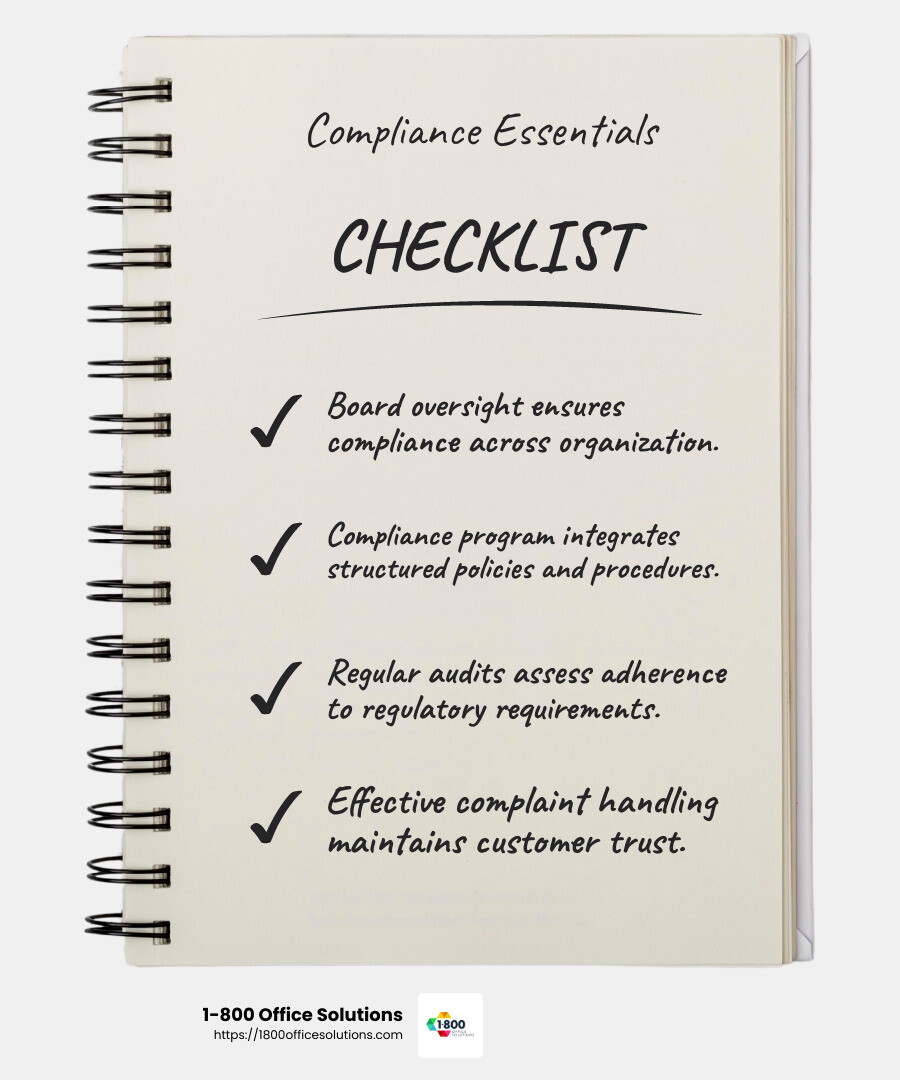
By focusing on these key components, organizations can create a robust compliance management system that not only meets regulatory requirements but also fosters a culture of integrity and ethical behavior. This sets the stage for our next topic: how to build an effective compliance management system.
Building an Effective Compliance Management System
Creating an effective compliance management system (CMS) requires a strategic approach. Let’s explore how risk assessments, employee training, and stakeholder engagement are vital in this process.
Risk Assessments
Risk assessments are like a roadmap for your compliance journey. They help you identify where potential problems might arise and how severe they could be. Think of them as your early warning system.
To conduct a risk assessment:
- List all compliance requirements: Gather information about all the regulations and standards your organization must follow.
- Identify potential risks: Look for areas where compliance might slip and the impact it could have.
- Prioritize risks: Rank these risks based on their potential impact and likelihood.
By understanding your risks, you can focus your resources on the most critical areas, preventing issues before they become costly problems.
Employee Training
Imagine a sports team without practice. They wouldn’t perform well, right? The same goes for your organization. Employee training is essential for a successful CMS.
Here’s why training matters:
- Keeps everyone informed: Regulations change, and training ensures your team knows the latest rules.
- Empowers employees: When employees understand compliance, they can make informed decisions and take proactive steps.
How to implement effective training:
- Regular sessions: Hold training sessions regularly to keep everyone updated.
- Role-specific training: Tailor training to different roles for maximum relevance.
- Interactive methods: Use quizzes or role-playing to make learning engaging and memorable.
Stakeholder Engagement
Engaging stakeholders is like building a support network for your CMS. It ensures everyone is on the same page and working towards the same goals.
Steps to engage stakeholders:
- Identify key stakeholders: These could be department heads, board members, or external partners.
- Communicate clearly: Share your compliance goals and how stakeholders can contribute.
- Involve them in decision-making: Get their input on compliance strategies and policies.
By involving stakeholders, you create a sense of ownership and accountability, making compliance a shared responsibility rather than an isolated task.
By focusing on risk assessments, employee training, and stakeholder engagement, organizations can build a compliance management system that is not only effective but also resilient. These elements work together to create a proactive approach to compliance, reducing risk and fostering a culture of integrity.
Let’s now explore the benefits of implementing a compliance management system in the next section.
Benefits of Implementing a Compliance Management System
Implementing a compliance management system (CMS) offers several key benefits for any organization. Let’s explore how it helps in risk reduction, regulatory adherence, and business growth.
Risk Reduction
Think of a CMS as your organization’s safety net. It helps catch potential issues before they become big problems. By proactively identifying and managing risks, a CMS minimizes the chance of costly fines, legal battles, and reputational damage.
Why risk reduction is crucial:
- Prevents financial losses: Avoid penalties and fines by staying compliant.
- Protects reputation: Demonstrates your commitment to ethical practices, which builds trust with clients and partners.
- Ensures operational continuity: Reduces disruptions caused by compliance failures.
Regulatory Adherence
Staying on top of ever-changing regulations can be overwhelming. A CMS simplifies this by integrating compliance into daily operations, ensuring your organization always meets legal standards.
Benefits of regulatory adherence:
- Avoids legal issues: Keeps your organization within the bounds of the law, preventing lawsuits and sanctions.
- Builds credibility: Shows regulators, clients, and partners that you take compliance seriously.
- Facilitates easier audits: A well-documented CMS makes it simpler to demonstrate compliance during audits.
Business Growth
A CMS doesn’t just protect your organization; it also supports growth. By streamlining processes and fostering a culture of compliance, a CMS can be a competitive advantage.
How a CMS fuels business growth:
- Improves operational efficiency: Reduces time spent on manual compliance tasks, allowing resources to focus on strategic initiatives.
- Attracts new clients: Clients are more likely to work with a company that is compliant and trustworthy.
- Supports strategic decision-making: Provides insights into compliance status, aiding in informed business decisions.
In summary, a robust compliance management system is more than a regulatory requirement—it’s a strategic asset. By reducing risks, ensuring regulatory adherence, and supporting business growth, a CMS plays a vital role in the long-term success of any organization.
Next, let’s address some frequently asked questions about compliance management systems.
Frequently Asked Questions about Compliance Management Systems
What is an example of a compliance management system?
A great example of a compliance management system is found in the healthcare industry. In healthcare, a CMS ensures the security and privacy of patient information. This system manages Protected Health Information (PHI) by enforcing strict access controls, so only authorized personnel can view sensitive data. This is crucial in maintaining patient trust and avoiding hefty fines for non-compliance with regulations like HIPAA.
How to build a compliance management system?
Building a compliance management system involves several key steps. First, board oversight is essential. The board of directors must prioritize compliance, creating a culture that values adherence to regulations. They should appoint a compliance officer to lead the efforts and ensure ongoing alignment with legal standards.
Next, establish a comprehensive compliance program. This includes developing written policies and procedures that clearly outline compliance expectations. Regular compliance audits are also vital. These audits evaluate adherence to internal policies and external regulations, identifying areas for improvement.
Finally, employee training is crucial. Regular training sessions help staff understand compliance requirements and their responsibilities. This ensures everyone in the organization is on the same page, reducing the risk of compliance breaches.
Which elements are included in a compliance management system?
A compliance management system typically includes several core elements:
- Written Policies: Clear guidelines and procedures that define compliance standards.
- Compliance Officer: A dedicated individual or team responsible for overseeing compliance efforts and maintaining communication with the board.
- Training: Ongoing education for employees to ensure they understand and can adhere to compliance requirements.
- Compliance Program: A structured approach that integrates compliance into daily operations, supported by regular compliance audits to assess effectiveness.
These elements work together to create a robust framework that helps organizations steer complex regulatory landscapes, ensuring they remain compliant and protect their reputation.
Next, let’s explore more about the benefits of implementing a compliance management system in your organization.
Conclusion
At 1-800 Office Solutions, we understand the importance of a well-crafted compliance management system. It’s not just about ticking boxes for regulatory compliance—it’s about creating a strategy that improves workplace productivity and fosters a culture of integrity.
Implementing a solid compliance strategy can significantly reduce risks. By proactively managing compliance, businesses can avoid costly fines and protect their reputation. This approach also supports business growth by building trust with stakeholders and clients who value transparency and accountability.
But a compliance management system offers more than just risk reduction. It also streamlines operations. With clear policies and regular training, employees know exactly what’s expected of them. This clarity boosts efficiency and minimizes errors, allowing your team to focus on what they do best.
Moreover, having a dedicated compliance officer ensures that compliance is not just an afterthought but a core part of your business strategy. This role involves overseeing compliance efforts, conducting audits, and maintaining open lines of communication. When everyone is aligned, your organization can operate smoothly and confidently.
In conclusion, a comprehensive compliance management system is a vital investment for any forward-thinking organization. At 1-800 Office Solutions, we are committed to helping you develop a compliance strategy that not only meets regulatory requirements but also improves your overall business performance.
Ready to take the next step? Explore how our Compliance Management System can benefit your organization today.




